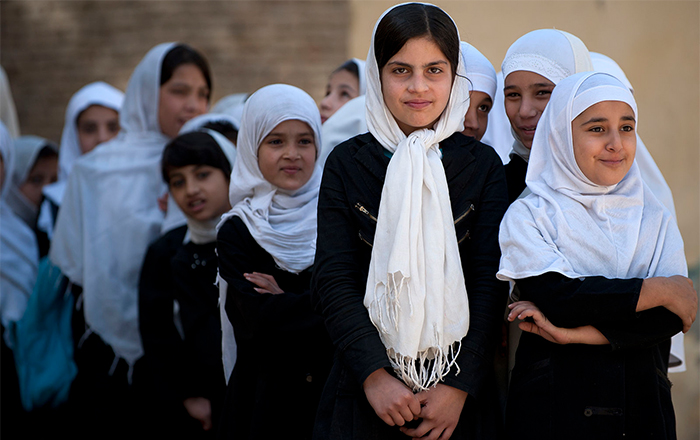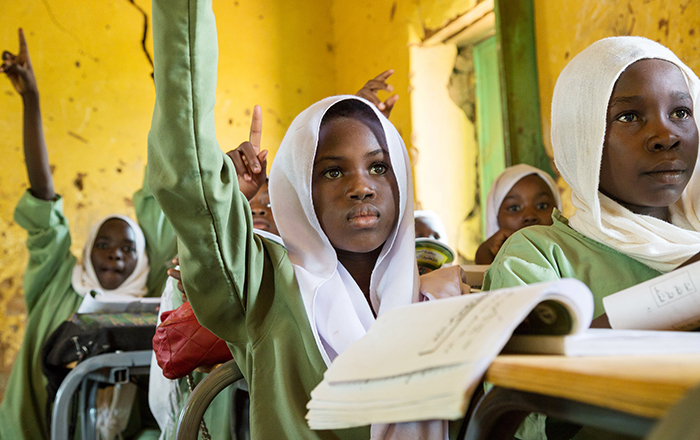 [1]
[1]International aid organizations often initially prioritize urgent, life-saving services over education, despite the latter’s significance. (credit: Wikimedia © NATO Training Mission-Afghanistan.)
“Returning to school … returning to life,” is the utmost dream for 14-year-old Salma, who has been displaced with her mother and siblings to the southern Gaza Strip for over a month because of the ongoing war there.
It is not the first time that education has been disrupted in Gaza, but this disruption is the longest.
Salma, a middle school student, says in a voice message via WhatsApp, “It doesn’t seem like we will return soon, the war seems endless. Even if the war stops now, everything is destroyed, our homes and schools. I can’t tell how tomorrow will look like.”
Salma is just one of more than 129 million out-of-school girls [2] around the world, girls who, like Salma, live in areas affected by conflict and face severe obstacles to obtaining an education. Not only are they more than twice as likely to be out of school than girls living in non-conflict zones, they are also 2.5 times more likely [3] to be out of school than boys in conflict zones. With the increasing prevalence and duration of conflicts worldwide, already widespread gender disparities in access to schooling are likely to increase. The consequences of these rising educational disparities will be detrimental for both the girls themselves and their communities.
“Conflicts are really exacerbating existing inequalities in access to education and skills building, particularly adolescent girls and girls with other intersecting vulnerabilities, such as the girls with disabilities or refugee girls or who are forcibly displaced,” said Jihane Latrous, gender manager at Education Cannot Wait [4], a global fund committed to finding ways to meet the educational needs of children impacted by conflicts.
Conflict zones erect a range of barriers that disproportionately impact girls’ access to education. First, the physical destruction of schools and public infrastructure profoundly damages educational systems’ ability to function and limits the availability of safe learning environments. As in Salma’s case, the forced displacement of families usually disrupts the schooling of young children and adolescents. It may also lead to the loss of academic records and other documentation needed by school-age children to continue their education elsewhere.
Second, international aid organizations often initially prioritize urgent, life-saving services, such as the provision of food, shelter, clean water, and medical assistance, over education, despite the latter’s significance. When aid organizations do offer educational opportunities to displaced individuals and refugees living in temporary camps, they often restrict their offerings to elementary education, leaving a gap in access to higher levels of education.
While these barriers impact all school-age children, they tend to fall heaviest on girls. Conditions in conflict-affected areas tend to reinforce discriminatory gender norms and harmful cultural practices, such as early marriage and forced labor.
A Growing Global Threat
In April 2014, Boko Haram militants abducted 276 girls [5] from the Government Girls Secondary School in Chibok, Borno State, Nigeria. The group, whose name roughly translates to “Western education is forbidden,” specifically targeted girls, driven by a belief that girls should not be educated and should instead be married off at a young age. The Chibok abduction was not an isolated incident. Boko Haram has been responsible for numerous attacks on schools, resulting in the displacement of thousands of students and teachers, particularly in northeastern Nigeria. These attacks have created a climate of fear and hindered girls’ access to education, as many families are now reluctant to send their daughters to school. While some of the Chibok girls have been rescued or managed to escape over the years, a significant number remain missing.
“Preventing girls from receiving education is usually used as a weapon of war in many conflict-affected countries,” said Eline Versluys, education manager with Gender at the Centre Initiative [6], a program coordinated by the United Nations Girls’ Education Initiative and the UNESCO International Institute for Educational Planning to promote gender equality “in and through education” in sub-Saharan Africa.
Conflicts impact girls across the world. A report [7] by the Global Coalition to Protect Education from Attack documented direct assaults on female students and teachers in at least 18 countries in Asia, Africa, and the Americas between 2014 and 2018.1 [8] More recently, the ongoing war in Ukraine has impacted access to schooling [9] in that country as well. (Read this related article: Mired in War, Ukraine Starts a New Academic Year [10]).
The types of attacks on girls vary, including the shelling of girls’ schools and the abduction of female students. Reports [11] have also emerged of sexual violence and forced marriages [12] in some instances. There are also less direct forms of attacks, such as closing girls’ schools or reallocating resources from girls’ to boys’ education, threatening girls to keep them away from school, and enforcing restrictive dress codes through violence.
According to Versluys, “Gender discrimination actually becomes worse during the conflict as the underlying gender norms then become more intensified. The impact of this does not stop with women alone, but extends to the entire society.”
For example, two years ago in Afghanistan, the Taliban implemented a ban on girls attending school beyond the sixth grade, making the country the only place in the world where such restrictions on female education exist. Unfortunately, girls in Afghanistan [13] continue to face limitations that prevent their pursuit of education beyond a certain level, and the opportunity to study abroad remains out of reach for them.
“Girls are being punished just because they have entered puberty, and their hopes and dreams are taken away from them,” said Maryam Rayed [14], a Fulbright scholar who was born and raised in Afghanistan.
Conflict may also have intensified gender-based violence in neighboring Iran. Last year, media outlets reported numerous cases of poison attacks [15] that affected hundreds of girls, approximately 10 years of age, in schools located in Qom, in the central region of Iran. These attacks took place during a period of protest in Iran, following the death of Mahsa Amini [16], a young woman who died after being arrested by the morality police for breaching the country’s stringent dress code.
“Increase in attacks on girls’ education is deeply concerning, it signifies a grave violation of their rights, perpetuating cycles of inequality and denying them opportunities for empowerment and protection,” said Latrous. “It’s crucial to ensure that there is not only access to education, but also retention.”
 [17]
[17]The types of attacks on girls vary, including the shelling of girls’ schools, the abduction of female students, and sexual violence and forced marriages in some instances. (Image: © GPE/ Kelley Lynch)
Escalating Attacks Demand a Comprehensive Defense
In 2015, the Safe Schools Declaration [18], a political agreement outlining a series of commitments to safeguard education during armed conflicts, was opened up to endorsements by UN member states. By endorsing the declaration, governments committed to taking steps to prevent attacks on schools, to support the restoration of education in conflict-affected areas, and to prioritize the safety of students, teachers, and educational facilities. The declaration underscores the significance of uninterrupted access to quality education for all children, including girls, both during and after conflicts. Despite 119 countries signing on to the declaration, attacks persist, and the threat continues to escalate. In 2020 and 2021, more than 5,000 instances [19] of violent attacks on educational establishments were reported.
“Girls’ education extends beyond mere enrollment in schools. It encompasses the provision of a secure learning environment that enables girls to complete all levels of education, acquire skills necessary for the workforce, develop socio-emotional abilities, make independent decisions, and contribute to their communities and the world,” said Latrous.
As barriers can vary, ranging from gender-based violence to the distance between schools and refugee camps, it’s important to closely examine each context and respond accordingly, GCI’s Versluys believes. She emphasizes the importance of international institutions cooperating with local communities. “Engaging with civil society is crucial for us to bring about change, especially when it comes to challenging harmful gender norms,” she said. “Achieving gender equality goes beyond mere access to education, as additional challenges like pregnancy or bullying may arise. Therefore, addressing a range of issues beyond gender parity is necessary to ensure comprehensive support for girls’ education in conflicts.”
According to Versluys, ensuring the right of girls to an education begins with educational curricula that teach boys the importance of education for both genders. “This transformative education should also not be limited to schools but extended to the local community, where it supports and embraces girls’ education instead of perpetuating conflict,” she said.
Carrie Bernier, executive director at Educate Girls [20], agrees with Versluys on the importance of engaging local communities in any program tackling girls’ education and changing gender norms.
“When the community is involved in locally led efforts, it helps to drive success and scale,” she said.
Educate Girls employs a community-based approach, working closely with local communities, parents, and government stakeholders to address social and cultural barriers to girls’ education. The charity is headquartered in the United States, but its primary operations and impact are focused on girls’ education in India.
“Using smart data and technology with high-touch community engagement and partnerships with state ministries, we can create a sustainable and systemic solution in the hope that one day every girl will be in school and learning,” Bernier said, pointing out that “technology and use of machine learning helped us operate at scale as we sought to geo-locate the out-of-school girls in the most rural and poverty-stricken areas of India.”
More Is Needed from Global Communities and Local Partners
While conflicts around the world persist and expand, the ongoing support of international institutions for girls’ education becomes increasingly critical. As a global community, we must identify measures that ensure and promote gender equality.
“It is crucial to ensure that all initiatives align with and fulfill the global commitments established. Multi-year funding with flexibility is essential, accompanied by a robust system for tracking accountability and results,” said Latrous. “This mechanism should allow us to monitor the extent to which we are achieving the commitments outlined in the various engagements mentioned earlier.”
Local activists also rely heavily on the international community.
“International organizations and the global community have a crucial role to play in supporting girls’ education in conflict-affected countries,” said Azizullah Royesh [21], a prominent advocate of equal access to primary and secondary education and the founder of Marefat High School [22] for Afghan refugees in Pakistan. “They must allocate more resources and engage in advocacy to ensure that all children, especially girls, have access to quality education,” he added.
Royesh, once a refugee himself, possesses a passion for transforming the lives of young Afghans through education. In 2004, he established the Marefat High School, bringing to life his vision of providing an education that extended beyond academics and where both boys and girls could thrive. Despite encountering significant obstacles, such as limited resources and societal resistance to girls’ education, Royesh remained resolute. He believed that education was the key to empowering individuals and to rebuilding Afghanistan’s future. By prioritizing girls’ education, he aimed to challenge deeply ingrained cultural gender norms and create opportunities for girls to flourish.
“I have personally witnessed the transformative power of education,” Royesh said. “Initiatives that focus on inclusive education, the establishment of safe and supportive learning environments, and the provision of psychosocial support can be particularly effective.”
1. [23] The countries identified in the report are Afghanistan, Cameroon, the Central African Republic, Colombia, the Democratic Republic of the Congo, Egypt, India, Iraq, Libya, Mali, Myanmar, Nigeria, Pakistan, the Philippines, South Sudan, Syria, Venezuela, and Yemen.
